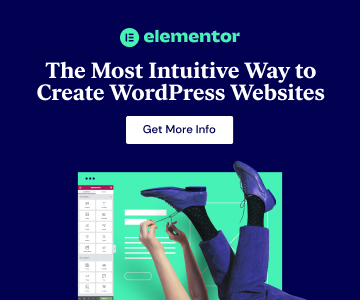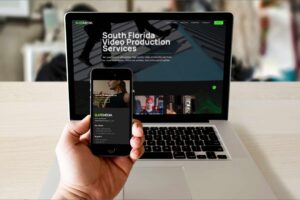For many company owners, building your own business website is an enticing alternative since it offers the advantages of total control and affordability. It is important to thoroughly consider the advantages and disadvantages of this methodology prior to arriving at a conclusion. Building a website is a complicated process that takes time, energy, and technical expertise, especially for people who have never done it before.
Being a full stack developer, it may come across as bias by suggesting most business owners not to build their own website, but there are very legitimate reasons to support my stance. In this article I will break down the positives and negatives of building your own website. Let’s zoom out for a moment and get a 30,000 ft. view of these pro’s and con’s.
| Pros | Cons |
| Cost Effective Decision Making Quicker Project Turnaround Passion & Authenticity | Time Commitment Limited Experience & Learning Curve SEO & Marketing Ongoing Maintenance Performance Knowing Too Much |
The Benefits (Pros) of Building Your Own Business Website
Cost Effective
More than ever, business owners are attempting to build their own website in an effort to save a little green – understandably. There are various platforms / website builders that help achieve this goal. GoDaddy, Wix, Webflow, Squarespace, Shopify, and Weebly are the first ones that come to my mind, but there are many other competitors to choose from.
Website Builder Prices in 2024:
| Basic Website Packages | |
| Wix GoDaddy Webflow Squarespace Weebly | $11/mo. – $149/mo. $5.49/mo. – $13.99/mo. $18/mo. – $49/mo. $23/mo. – $33/mo. $10/mo. – $26/mo. |
In many cases, these prices are inclusive of domain / url (your website address), hosting and the building tools to construct your website; and as you can see by the prices above, it’s no mystery as to why small businesses owners decide to go down this path on the first-go.

When you use these builders you don’t have to hire a web designer every time you want to update your website – adding or changing text, images, and videos. Small businesses that are just starting out and testing the water, a website builder may be the most cost effective option.
Decision Making
Creating your own website is a difficult choice that has benefits and drawbacks to take into account. There’s no one in your way or questioning your ideas or methods. If you want a green and red colored theme, it’s your choice. If you want to use a display font like “Collegiate” as your paragraph font because it reminds you of that one year in high school the football team went to finals…there’s no one stopping you.
Quicker Project Turnaround
When working with an agency or freelance contractor like myself, there’s time invested into the back-and-forth communication, approvals, etc. Usually, project management has its own category and cost. Building your own business website gives you the freedom and reigns to execute on ideas as soon as they come to your mind, and if you want to pivot after, it’s your choice. This alone greatly reduces the project’s timeline, allowing you to get your business in front of potential clients faster. Or on the flipside, if you need a more flexible timeline, you can take as long as you like.
Passion & Authenticity
While building your own business website allows you to fully express your brand’s unique identity and passion, it’s crucial to weigh the commitment and technical expertise required before diving in. No one knows your business better than you. You are the boots on the ground and no one can argue that.
Small business owners are often very passionate about their product or service. From the design and messaging to product descriptions and customer interactions, this authenticity can shine through in a website owners build themselves. Not to mention, customers appreciate businesses that are genuine, transparent, and true to themselves. It fosters trust and connection with customers.
The Disadvantages (Cons) of Building Your Own Business Website
To be clear, the disadvantages outweigh the benefits, not in an effort to discourage you, but rather help you prepare your expectations.
Time Commitment
Building a website can be as simple as registering a domain, adding some text and images, then going live. It takes a lot of work to draw in local clients and increase organic traffic. You’ll need to anticipate an investment of time into the following:
- Planning:
- Layout wireframing for desktop and mobile
- Section and content within
- Copywriting and keyword research
- Executing:
- Constructing the desktop and mobile layouts of your website
- Creating the imagery – Graphics, photos, and video
- Add and enhance media on your website to improve SEO and responsiveness.
- Include locally optimized material for search engines that makes use of long-tail and pertinent keywords from your study.
- Testing: As you’re executing you’ll be going back and forth checking between devices for responsiveness. Making sure the website loads quickly, text sizes are legible, and media loads properly in the different view ports.
- Monitoring: Even when your website is complete, you should be monitoring your visitors’ activity. This way you understand their journey to becoming a conversion – using tools like Hotjar are great for this. You can monitor how far users scroll, where they click, etc.
Limited Experience & Learning Curve
Business owners attempting to build their own website with little or no experience will certainly undergo a big learning curve, and in reality it goes hand-in-hand with the aforementioned disadvantage “Time Commitment”. While platforms like Wix, Squarespace, or even WordPress websites with a premade theme can make the project far more affordable, there is still a lot to learn.

What will you need to learn?
- Whichever platform you ultimately decide to build your website on, you’ll need to learn their workflow and experiment with their tool’s capabilities.
- Learn effective SEO methods to rank in search engines naturally.
- It would be very helpful to have a healthy understanding of web design principles and user experience considerations.
- Selecting dependable plugins or understanding a little JavaScript may be necessary for implementing dynamic features.
SEO & Marketing
I can tell you this from years of expertise in SEO and marketing: it’s always changing, much like website design and development. While building your own business website allows you more control over the content and design, it also comes with the responsibility of staying up-to-date with SEO best practices. You’ll need to continuously evaluate and refine these optimizations after tackling the initial learning curve of understanding how to rank well. Over time, the keywords and long-tail keywords used to find your business evolve. If you don’t monitor this and fail to refresh your website content regularly, you could potentially miss out on potential customers.
Marketing is a pretty broad term, but relating to website conversion generation for small businesses, the elements I focus on are primarily:
Social Media Marketing
You have to stay in front of your base regularly. This doesn’t mean sharing posts every day, but at least a couple days per week. What’s involved?
- Brainstorming what you would like to post and developing a schedule of these posts, stories, reels, etc.
- Creating those posts, reels, stories, etc. Which means you’ll have to also research good practices to improve your organic reach with those posts.
- Monitoring user engagement so future posts are: 1.) Getting in front of the largest percentage of your base. 2.) Engaging them!
Email Marketing
Similar to social media marketing; brainstorming, scheduling, developing, and monitoring are all vital steps. Making sure your emails are landing in their inbox, rather than their spam folder is a job in itself.
If you’re a small business just starting out,, my advice is to attack in manageable bite size pieces. Start by sending out quarterly email marketing communications. It’s a nice balance between being informative and not too pushy. Earning the inbox of your recipients is almost as valuable as gold. If you can get in there and get them to regularly open your communications, you’re doing a great job. The average open rate is 40% in 2024, so if you’re in or around that percentage, give yourself a pat on the back.
Now, unless you have new products in rotation constantly, then I suggest a more frequent schedule. For example, dealerships sharing new inventory arrivals should be sharing once per month to start, then increase to twice per month over time – this is when a business can afford to burn subscribers.
Ongoing Maintenance
WordPress website development calls for constant upkeep. WordPress is far superior when it comes to searchability and dynamics, but you will need to care for it. Anticipate to learn and maintain the following:
- Updating Plug-ins
- Updating Databases
- Updating Theme files
- Checking the integrity of the website after updates
- Running backups
- Restoring backups
- Running test purchases
- Fixing your website if it crashes or when there is a conflict between plugins
Performance

If you intend on building your own website, it’s important to understand that performance issues will hinder your ability to rank on Google. Google wants to serve the best results to it’s customers and performance plays a big roll in it’s analysis. If Google ranked websites that were irrelevant to your search perimeters or slow to load, users would use different search engines.
Things that can affect the performance of your website:
On-page SEO:
- Content: This refers to the caliber, applicability, and recentness of the information on your website. Websites that satisfy consumers’ search intent and offer them useful and helpful material are what Google wants to see.
- Keywords: Use relevant keywords strategically in your website content, title tags, meta descriptions, and headers to help Google understand your website’s purpose and target audience. Remember, keyword stuffing can hurt your ranking, so avoid it.
- Technical SEO: This is about the technical features of your website, such its crawlability, speed, and friendliness on mobile devices. Google aims to make sure that websites are simple to use and easy for its crawlers to index.
Off-page SEO:
- Backlinks: Backlinks are connections to your website made by other websites. Websites having a lot of high-quality backlinks typically rank better in search results because Google views backlinks as an indication of authority and trust.
- Social cues: Even while Google hasn’t officially acknowledged them as ranking factors, social media mentions and shares can nevertheless affect how highly your website ranks. Positive social signals can indicate to Google that your website is valuable and engaging.
- User-friendly design (UX): This has to do with how simple it is for visitors to utilize your website and traverse it. webpages with high bounce rates and short stay periods may face penalties from Google, which favors user-friendly web pages.
Other Factors:
- Hosting Service: The type and location of your website’s hosting service can also impact performance. There are mainly four types of servers: Shared, VPS, and Dedicated, and Cloud Servers.
If your business is located in Michigan and the server your website is on is located in California, although not a huge deal, there would be a bit of latency as a result of the information coming from the other side of the country.
Cloud Servers typically have nodes all over the country and on each one of those nodes is a copy of your website. This way if your visitor is in Michigan and there’s a node in Ohio, the visitor will pull the data from that node rather than from the one in California.
Because most of my clients are from Michigan or on the east coast, my Shared and VPS Servers are located in Washington D.C.
- Third Party Services: As previously mentioned, when building on a more dynamic platform like WordPress, you have to pay attention to how many Plug-ins you have installed on your website. While WordPress plugins offer great functionality and customization, having too many installed can negatively impact your website’s performance in a few ways:
- Increased Server Load and Slower Loading Speeds
- Compatibility Issues and Conflicts
- Security vulnerabilities
Knowing Too Much
Why would knowing too much be a bad thing for a small business owner wanting to build their own website?
While it’s true that you, the entrepreneur, are the undeniable expert in your business and industry, building your own business website and crafting its content comes with a unique challenge: ensuring the information resonates with your target audience. Often, when entrepreneurs write their own content, including descriptions and features for their products or services, the details can go over the heads of readers.
Rewrite the information to be clear and concise for your visitors, avoiding lengthy explanations and complex jargon. Otherwise, it can confuse and disinterest them, leading to a higher bounce rate. As the bounce rate increases, Google recognizes this and inevitably ranks your website lower because it’s clearly not valuable to visitors.
Seek the right fit for your business:
Even while creating your own website might seem empowering and much more affordable alternative, think about the possible downsides and how they can affect your company’s objectives. Recall that hiring a professional web designer or agency may help you keep focused on your main company operations while providing knowledge, effectiveness, and continuous assistance that might ultimately result in a larger return on investment.




